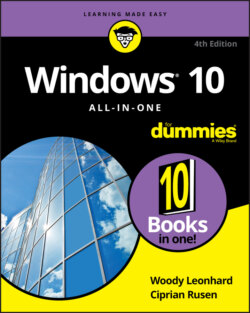Читать книгу Windows 10 All-in-One For Dummies - Ciprian Adrian Rusen, Woody Leonhard - Страница 32
Managing disks and drives
ОглавлениеYour PC’s memory chips hold information only temporarily: Turn off the electricity, and the contents of main memory go bye-bye. If you want to reuse your work, keeping it around after the plug has been pulled, you have to save it, typically on a hard drive, or possibly in the cloud (which means you copy it to a location on the Internet).
The following list describes the most common types of disks and drives:
Hard drive: The technology’s changing rapidly, with traditional hard disk drives (HDDs) now being rapidly replaced by solid-state drives (SSDs) with no moving parts, and to a lesser extent hybrid drives that bolt together a rotating drive with an SSD. Each technology has benefits and drawbacks. Yes, you can run a regular HDD drive as your C: drive, and it's going to work fine. But tablets, laptops, or desktops with SSD drives run like greased lightning.The SSD wins as speed king. After you use an SSD as your main system (C:) drive, you’ll never go back to a spinning platter, I guarantee. SSDs are great for the main drive, but they may be expensive for storing pictures, movies, and photos. They may supplant the old whirling dervish drive, but price and technical considerations (see the sidebar “Solid-state drives have problems, too”) assure that hard drives will still be around. SSDs feature low power consumption and give off less heat. They have no moving parts, so they don’t wear out like hard drives. And, if you drop a hard drive and a solid- state drive off the Leaning Tower of Pisa, one of them may survive. Or maybe not.Hybrid drives combine the benefits and problems of both HDDs and SSDs. Although HDDs have long had caches — chunks of memory that hold data before being written to the drive, and after it’s read from the drive — hybrid drives have a full SSD to act as a buffer.If you can stretch the budget, start with an SSD for the system drive, a big hard drive (one that attaches with a USB cable) for storing photos, movies, and music, and get another drive (which can be inside your PC, outside attached with a USB cable, or even on a different PC on your network) to run File History (see Book 8, Chapter 1). If you want full on-the-fly protection against dying hard drives, you can get three hard drives — one SSD, and two hard drives, either inside the box or outside attached with USB or eSATA cables — and run Storage Spaces (see Book 7, Chapter 4).Ultimately, though, most people opt for a fast SSD for files needed immediately, coupled with cloud storage for the big stuff. Now that Google offers free unlimited photo storage — and with the rise of data streaming instead of purchased CDs — the need for giant hard drives has hit the skids.For the enthusiast, a three-tier system, with SSDs storing data you need all the time, intermediate backup in the cloud, and multi-terabyte data repositories hanging off your PC, seems to be the way to go. Privacy concerns (and the, uh, intervention of various governments) have people worried about cloud storage. Rightfully so.
SD/xD/CF card memory: Many smaller computers, and some tablets, have built-in SD card readers. (Apple and some Google tablets don’t have SD — the companies would rather sell you more on-board memory, at inflated prices!) You probably know Secure Digital (SD) cards best as the kind of memory used in digital cameras, or possibly phones (see Figure 1-8). A microSD card may slip into a hollowed-out card that is shaped like, and functions as, an SD card. Even now, long after the demise of floppy disks, many desktop computer cases have drive bays built for them. Why not use the open spot for a multifunction card reader? That way, you can slip a memory card out of your digital camera (or your Dick Tracy wristwatch, for that matter) and transfer files at will. SD card, miniSD, microSD card, xD card, CompactFlash, memory stick — whatever you have — the multifunction readers cost a pittance and read almost everything, including minds.Source: Skcard.svg, WikimediaFIGURE 1-8: Comparative sizes of an SD, a miniSD, and a microSD card.
CD, DVD, or Blu-ray drive: Of course, these types of drives work with CDs, DVDs, and the Sony Blu-ray discs, which can be filled with data or contain music or movies. CDs hold about 700MB of data; DVDs hold 4GB, or six times as much as a CD. Dual-layer DVDs (which use two separate layers on top of the disc) hold about 8GB, and Blu-ray discs hold 50GB, or six times as much as a dual-layer DVD.Fewer and fewer machines these days come with built-in DVD drives: If you want to schlep data from one place to another, a USB drive works fine — and going through the cloud is even easier. For most storage requirements, though, big, cheap USB drives are hard to beat.
USB drive or key drive: Treat it like it’s a lollipop: It's half the size of a pack of gum and able to hold an entire PowerPoint presentation or two or six, plus a few full-length movies. Flash memory (also known as a jump drive, thumb drive, or memory stick) should be your first choice for external storage space or for copying files between computers. (See Figure 1-9.) You can even use USB drives on many DVD players and TV set-top boxes.Pop one of these guys in a USB slot, and suddenly Windows 10 knows it has another drive — except that this one’s fast, portable, and incredibly easy to use. It's okay to go for the cheapest flash drives you can find. Some of the features on fancy USB drives are not useful to many users.
Source: Nrbelex, Wikimedia
FIGURE 1-9: The inside of a USB drive.
